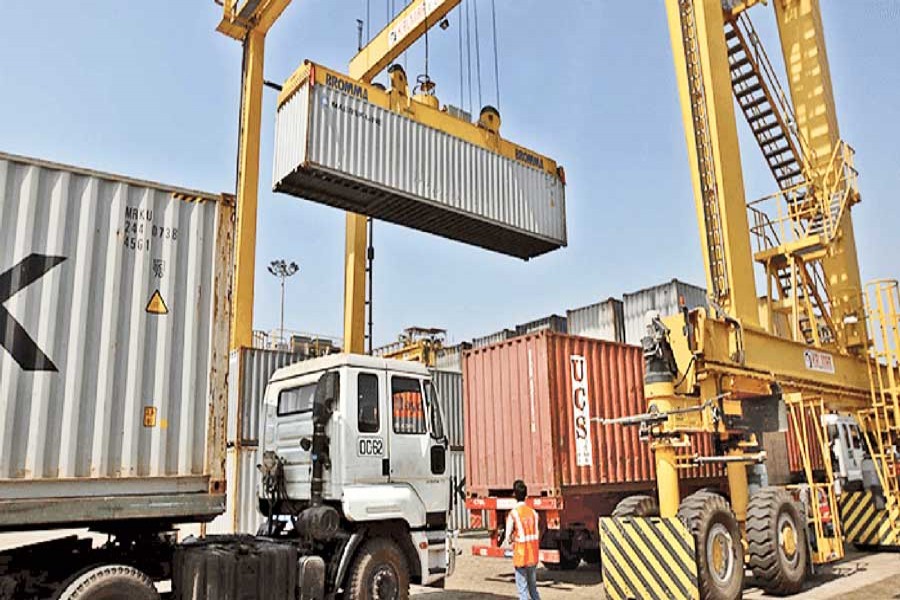
Ctg port: Growing in importance
FE REPORT | Monday, 9 December 2019

 The container handling capacity and activities at the seaport in Chattogram, the prime seaport of the country, are increasing now more than before.
The container handling capacity and activities at the seaport in Chattogram, the prime seaport of the country, are increasing now more than before.
The port set a new record in handling containers in September. The port operators handled 2 92,455 TEUs of containers in September.
Earlier, the port operators handled 265,000 TEUs in November last year, which was the highest by then. But handling of 292,455 TEUs of containers within a month is the new record for the prime seaport.
Enamul Karim, Director (Transport) of Chittagong Port Authority (CPA), said, "Chittagong Seaport set a new record in handling of containers. In September, the port handled 292,455 TEUs of containers which is a record. Of the total, 272,922 TEUs of containers were handled at the port, 9,338 TEUs of containers at Kamalapur ICD, 3,853 TEUs of containers at Pangaon Terminal and 6,332 TEUs of containers at off-docks."
The seaport handled 2,667,000 TEUs of containers in 2017 and 2,903,000 TEUs of containers in 2018. The rate of handling of containers increased 13 per cent last year.
A total of 3,370 ships berthed at the seaport in 2017 and 3,747 ships in 2018. Besides, the stay time of ships at the port decreased last year more than the previous years.
Presently the off-dock container carrier ships are staying at the port only for 35 hours while export container carrier ships are leaving the port within an hour only. Besides, stay time of ships carrying imported containers was not more than seven days last year while the time was 8 to 9 days in 2017.
The seaport moved six notches up to be the 64th busiest container port among 100 top ports across the world, according to the latest Lloyd's List, the world's oldest journal on port and shipping. The 2019 edition of Lloyd's List of 100 Ports was recently published, tallying up the annual container throughput figures of the world's elite port facilities in 2018. The port was ranked 70th in 2018 and 71st in 2017 in the list. The Chinese port of Shanghai with a throughput of 42.01 million TEUs clinched the top position in this year's chart.
The port is being developed by procuring equipment, constructing new terminals and other facilities. After 132 years of the CPA the government is going to solve the crisis of the port.
Omar Faruk, Secretary to the CPA, said, "The port obtained the 64th position among the 100 ports of the world. The position of port was 70th in 2018 and 71st in 2017."
He said, "A number of projects have increased the ports' inner berth capacity, besides, construction of the new north yard beside the Rubi Cement and procurement of heavy modern handling equipment helped break all previous records of container handling."
The CPA has introduced strict limits on how long a ship may stay at the port, aiming to quicken loading and unloading of containers and reduce acute congestions and improve productivity, he added.
Chairman of CPA Rear Admiral Zulfikar Aziz said, "By following the vision 2021 of the incumbent government, the port will be the friendliest one for the users within the current year."
He said, 'Management of the increased handling of containers is being a big challenge for the CPA now. We have already taken many plans including short-term, mid-term and long-term plans for making the port most modern one to meet the challenges of the future."
He said, "Now we are working to construct a 1,500-metre long multipurpose terminal and two container terminals with 1,225-metre and 800-metre length respectively. The construction of the three terminals will be completed by 2025."
"Currently, container vessels are getting the berthing within one or two days after arriving at the outer anchorage of the port. The turnaround time for vessels was 7to 8 days in 2017. But the container handling activities have gained momentum at the port due to the installation of key gantry cranes. As a result, container vessels now have to spend less time at the jetties," he added.
He also said, "In 2017, 10 to 12 container vessels had to stay at the outer anchorage of the port every day. In 2018, the number of ships declined to 2 to 3. Meantime, the number of vessels berthing at the port increased. 3,370 ships berthed at the port in 2017 while the number increased to 3,747 in 2018."
He further said, "Chittagong Port has already achieved around 9% growth in container handling and 13% growth in cargo handling. We have managed to cope with the ever-increasing growth in the container handling due to the renovation and the construction of the yards. Currently, the maritime port has the capacity of accommodating 50,000 containers in its yards."
"As part of the short-term and long-term plans, the project for constructing four terminals has already been finalized. The terminals are Bay Terminal, Patenga Container Terminal, Laldia Multipurpose Terminal, and the Karnaphuli Container Terminal," said the CPA chairman.
"Now a vessel with a length of 190 metres and a draft of 9.5 metres can berth at the port during high tide. With the construction of Bay Terminal, vessels with more draft and length could berth at the jetties of the port," he said.
He also said, "We have procured more than 60 pieces of equipment for the port at a cost of Tk 1,000 crore in 2018 including six Ship-to-Shore Gantry Crane used for container handling. Four more gantry cranes will be added to the fleet in the current year. We procured Rail Mounted Gantry Crane at a cost of Tk 22 crore for the first time in 2018. Besides, Rubber Tyre Gantry Cranes (RTG), forked lift and straddle carriers were procured in the previous year."
He said, "92 per cent of the export and import of Bangladesh is taking place through the seaport. We handled a total of 98 per cent of our containers in the current year while Mongla port handled only 2.0 per cent of containers."
Mentioning that the port is the nerve centre of the economy of the country he urged all to cooperate for continuing smooth operation of it.
The main significance of this port lies in the fact that it provides a deep-water anchorage a few miles inland from the sea. The steering distance is 16 km from the outer berth in the Bay of Bengal to the main berths on the bank of the river Karnaphuli.
The location of the port and its natural harbour made it an important centre of trade and business since as far back as the 9th century AD when the Arab merchants found it to be a lucrative centre for trade.
By the beginning of the 15th century, the port was an important trading centre. Chinese Chronicler Ma Huan, who visited Chattogram in 1405 with a Chinese mission, refers to 'Chit-le-Gan' as a port frequented by Chinese trading vessels. The most frequent visitors to the port were the Arabs.
Among the Europeans, the Portuguese were the first to arrive at Chattogram. The Portuguese tried twice, without success to capture Chattogram, first in 1517 under John de Silviera and again in 1527 under Alfonso-de-Millo.
Finally they secured it and Satgoan, from Mahmud Shah the ruler of Bengal, in return for helping him against Sher Shah Sur. Under the Portuguese, Chattogram prospered and became a commercial centre acquiring the title of 'Porto Grande', the great port, as opposed to Satgoan, the 'Porto Pequene'. In 1665-66 Shaista Khan, the Mughal Viceroy of Bengal, advanced on the port and took it by storm.
However, since 1971, the Chattogram sea port, the prime sea port of the country, has been being developed as a modern port. With the birth of Bangladesh in 1971 the trade of the port expanded greatly. To cope with the rapid development and expansion of the port, the government of Bangladesh promulgated the Chattogram Port Authority Ordinance in 1986 and dissolved the Port Trust.
nazim07@yahoo.com